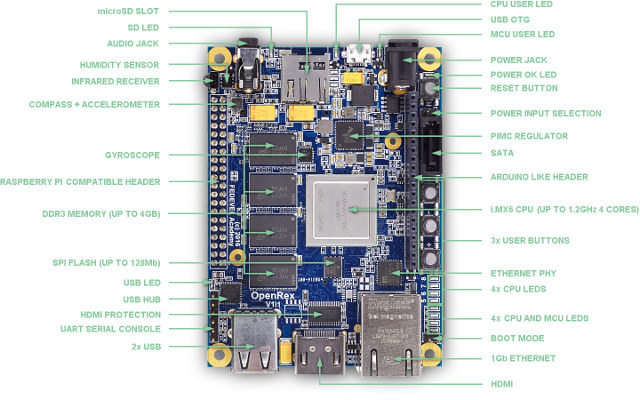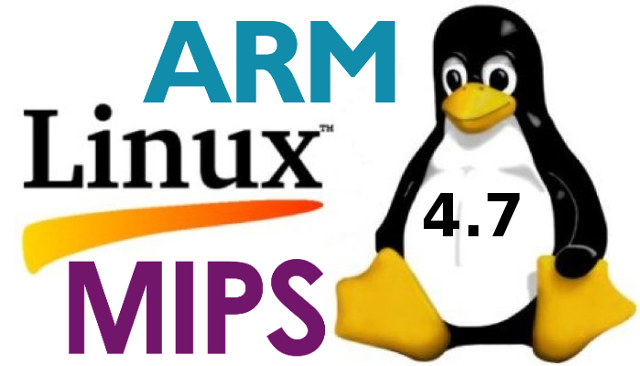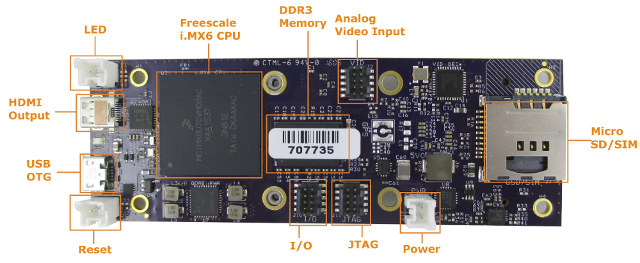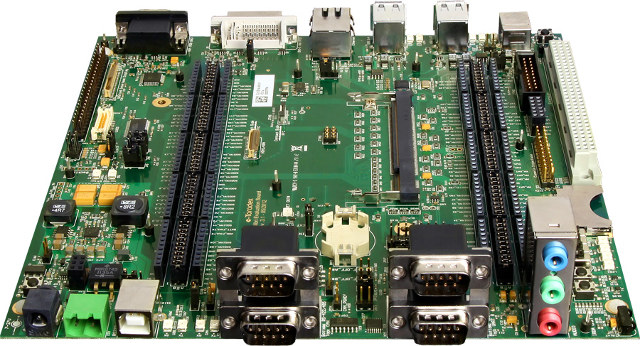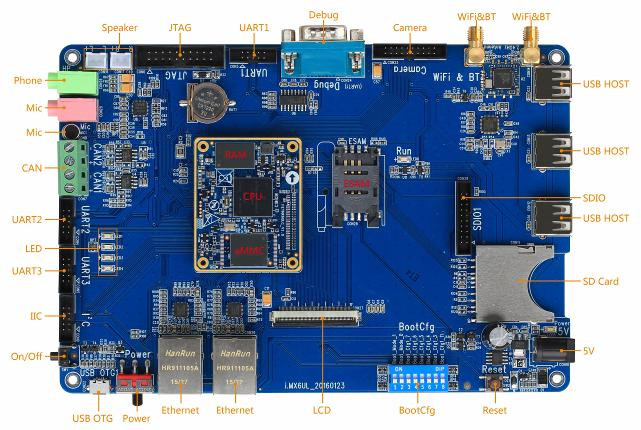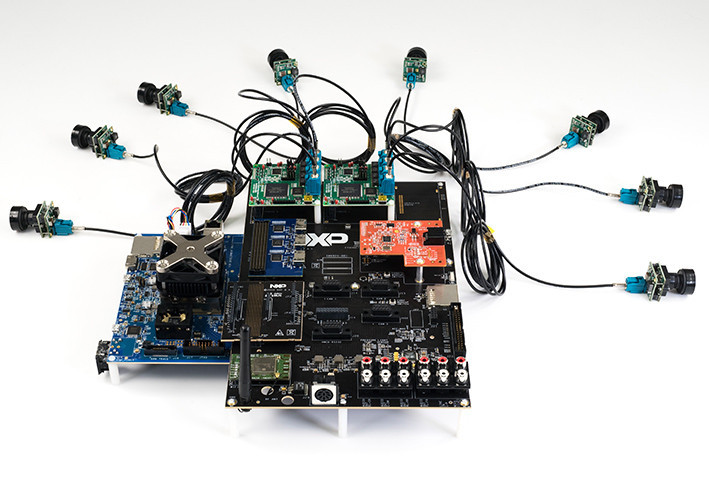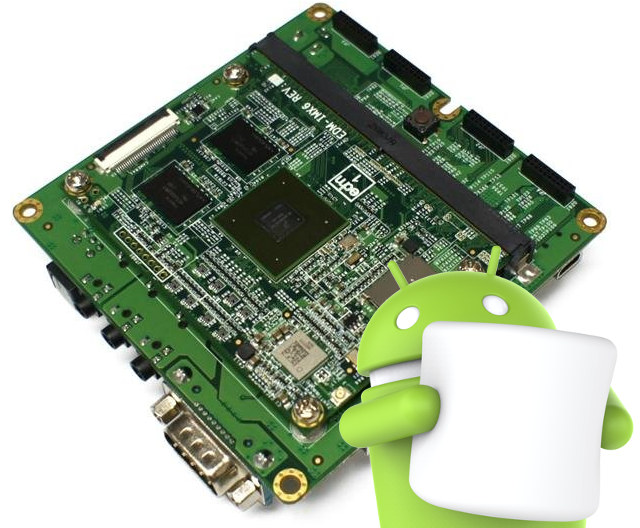OpenRex is an open source hardware board powered by NXP i.MX6 Cortex A9 processor designed by Fedevel for their hardware design course, and manufactured by Voipac, both companies based on Slovakia. The schematics, PCB layout, gerber files and other manufacturing files were released in February, but the company has only started selling the board a few days ago with OpenRex Basic SBC and OpenRex Max SBC boards. OpenRex Basic and Max boards specifications: SoC OpenRex Basic – NXP i.MX 6Solo single core Cortex A9 processor @ 1 GHz with 2D and 3D GPU OpenRex Max – NXP i.MX 6Quad quad core Cortex A9 processor @ 1 GHz with 2D and 3D GPU MCU – NXP LPC1345FHN33 ARM Cortex-M3 micro-controller @ 72 MHz System Memory Basic – 512 MB DDR3-1066 (400MHz) Max – 2GB DDR3-1066 (533 MHz) Storage Basic – micro SD slot, 1x 2Kbit I2C EEPROM, 1x 32Mbit SPI flash Max […]
Linux 4.7 Release – Main Changes, ARM and MIPS Architectures
Linux 4.7 is out: So, after a slight delay due to my travels, I’m back, and 4.7 is out. Despite it being two weeks since rc7, the final patch wasn’t all that big, and much of it is trivial one- and few-liners. There’s a couple of network drivers that got a bit more loving. Appended is the shortlog since rc7 for people who care: it’s fairly spread out, with networking and some intel Kabylake GPU fixes being the most noticeable ones. But there’s random small noise spread all over. And obviously, this means that the merge window for 4.8 is open.Judging by the linux-next contents, that’s going to be a bigger release than the current one (4.7 really was fairly calm, I blame at least partly summer in the northern hemisphere). Linus Linux 4.6 brought USB 3.1 superspeed, OrangeFS distributed file system, 802.1AE MAC-level encryption (MACsec), and BATMAN V protocol support, improved […]
Gateworks Ventana GW5530 SBC is Designed for Drones, Robots, and Digital Signage
Gateworks Ventana is a family of boards based on NXP i.MX6 processor designed for embedded applications, and often include one or more mini PCIe ports for expansion. Their latest single board computer – Ventana GW5530 – is powered by an NXP i.MX 6Dual processor coupled with 512MB RAM, 256MB storage, a mini PCIe port, a micro SD / SIM card slot, micro HDMI output, and some I/Os. Ventana GW5530 specifications: SoC – NXP i.MX6 Dual Core ARM Cortex-A9 processor @ 800MHz with Vivante 2D and 3D GPUs System Memory – 512MB DDR3 (Up to 2GB as option) Storage – 256MB flash (Up to 2GB as option), micro SD/SIM card slot, serial configuration EEPROM Video & Audio Output – micro HDMI 1.4 port Connectivity – Optional u-blox EVA-M8M GPS Receiver with MMCX or u.FL Antenna Connector USB – 1x micro USB 2.0 OTG Port Sensors – 9-axis inertial module (accelerometer/gyro/magnetometer) Expansion […]
Setting a VoIP SIP user agent with Embedded Linux
This is a guest post by Leonardo Graboski Veiga, working for Toradex. Introduction This article’s main goals are: to cross-compile the PJSIP libraries and the PJSUA API reference implementation; deploy it to the target system; give an overview about the SIP protocol; and explore the reference implementation features, regarding audio only. For this purpose, a Computer on Module (CoM) from Toradex was chosen in the following configuration: Colibri iMX6DL* + Colibri Evaluation Board. The evaluation board and CoM are displayed in Figures 1 and 2, respectively. VOIP or Voice over IP, is a term designed to refer to a set of methods and technologies targeted for the implementation of telephony services over the Internet. For the purpose of this article, the scope will be limited to the use of a reference implementation built upon the SIP communication handling protocol by means of the PJSIP libraries and PJSUA2 API. If […]
Forlinx i.MX6UL Linux Single Board Computer Supports ESAM Embedded Security Control Module
Forlinx Embedded has introduced i.MX6UL single board computer (SBC) based on NXP i.MX 6Ultralite Cortex A7 processor with 512 MB RAM, 8GB storage, that includes two Ethernet interface, an LCD interface, a CAN bus, as well as ESAM (Embedded System Access Module) support via either a SIM card like slot, or a 8-pin DIP chip compatible with ISO7816 standard, and typically used in the financial, telecommunications, transportation sectors for authentication and secure data transfer. Forlinx I.MX6UL board specifications: System-on-module: SoC – NXP i.MX 6Ultralite ARM Cortex A7 processor @ up to 528 MHz with 2D graphics GPU System Memory – 512 MB LvDDR3 memory Storage – 8GB eMMC flash (but hardware manual says 1GB eMMC flash, but also mentioned MTFC8GACAAAM-1M WT so it must 8GB after all…) 2x 80-pin board to board connectors with signals for 2x CAN bus, 2x USB device, 2x SDIO, 2x 10/100M Ethernet, 24-bit RGB, 4x […]
NXP Unveils i.MX 8 Multisensory Enablement Kit with Hexa Core ARMv8 Processor
Freescale, now NXP, i.MX 8 processors have been a long time coming, but finally the company has now unveiled a Multisensory Enablement Kit based on i.MX 8 hexa core ARMv8 processor combined with a Vulkan-ready & OpenCL capable GPU. Key features of the development kit: Multisensory Processor Board Multisensory Expansion Board Isolation and separation of secure, safe and open domains Rich compute (6x ARMv8 64-bit main CPUs, OpenCL GPU) Vulkan-ready GPU with HW tessellation and geometry shading Efficient, multi-screen (4x) support via HW virtualization Failover-ready display path Up to 8x camera input for 360 degree vision Integrated vision processing HDR enhanced video Multi-sensor fusion and expansion Multi-core audio and speech processing NXP radio solution integration However, at the time of writing, there’s very little information about i.MX8 processors themselves, but I’m confident much more info should soon surface as NXP FTF 2016 is taking place now until May 19, 2016. […]
Linux 4.6 Release – Main Changes, ARM and MIPS Architectures
Linus Torvalds released Linux Kernel 4.6 earlier today: It’s just as well I didn’t cut the rc cycle short, since the last week ended up getting a few more fixes than expected, but nothing in there feels all that odd or out of line. So 4.6 is out there at the normal schedule, and that obviously also means that I’ll start doing merge window pull requests for 4.7 starting tomorrow. Since rc7, there’s been small noise all over, with driver fixes being the bulk of it, but there is minor noise all over (perf tooling, networking, filesystems, documentation, some small arch fixes..) The appended shortlog will give you a feel for what’s been going on during the last week. The 4.6 kernel on the whole was a fairly big release – more commits than we’ve had in a while. But it all felt fairly calm despite that. Linux 4.5 added […]
Wandboard Development Boards Get Android 6.0 Marshmallow Support
Wandboard development boards powered by Freescale i.MX6 Solo, Dual and Quad Cortex A9 processors were released over 3 years ago with Android 4.1 Jelly Bean. Contrary to many other boards that don’t get an updated version, Wandboard boards got support for Android 4.4 Kitkat, Android 5.x Lollipop, and now the community has recently released Android 6.0 Marshmallow. You can try the Android 6.0 SD card image as follows:
|
1 2 3 |
wget http://download.wandboard.org/wandboard-imx6/android-6.0/wandboard-all-android-6.0.1-sdcard-20160428.zip unzip wandboard-all-android-6.0.1-sdcard-20160428.zip sudo dd if=wandboard-android-6.0.1-ga-20160428-sdcard.img | pv | sudo dd of=/dev/sdX bs=16M |
Where /dev/sdX is the device for your SD card. If you can remember the first Jellybean release had separate images for each version of the board, but thanks to device tree implementation, a single image is now released with all three versions. The full source code is also available in a 5.0 GB tarball. Since Freescale, now NXP, i.MX6 processors will be available until November 2022, we can most probably expect a few more Android releases for the board. Jean-Luc Aufranc […]


